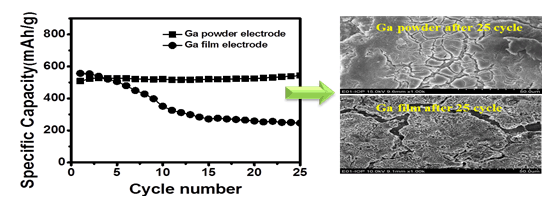| [1] Zhang, W.-J. J. Power Sources 2011, 196, 13.
[2] Zhang, W.-J. J. Power Sources 2011, 196, 877.
[3] McDowell, M. T.; Lee, S. W.; Nix, W. D.; Cui, Y. Adv. Mater. 2013, 25, 4966.
[4] Wang, B.; Yang, J.; Xie, J.; Wang, K.; Wen, Z.; Yu, X. Acta Chim. Sinica 2003, 61, 1572. (王保峰, 杨军, 解晶莹, 王可, 文钟晟, 喻献国, 化学学报, 2003, 61, 1572.)
[5] Ye, Y.; Zhu, J. Y.; Yao, Y. N.; Wang, Y. G.; Wu, P.; Tang, Y. W.; Zhou, Y. M.; Lu, T. H. Acta Chim. Sinica 2015, 73, 151. (叶亚, 朱婧怡, 姚依男, 王雨果, 吴平, 唐亚文, 周益明, 陆天虹, 化学学报, 2015, 73, 151.)
[6] He, Y.; Yu, X. Q.; Li, G.; Wang, R.; Li, H.; Wang, Y. L.; Gao, H. J.; Huang, X. J. J. Power Sources 2012, 216, 131.
[7] Li, H.; Huang, X. J.; Chen, L. Q.; Wu, Z. G.; Liang, Y. Electrochem. Solid-State Lett. 1999, 2, 547.
[8] Chan, C. K.; Peng, H.; Liu, G.; McIlwrath, K.; Zhang, X. F.; Huggins, R. A.; Cui, Y. Nat. Nanotechnol. 2007, 3, 31.
[9] Yang, Z.; Guo, J.; Xu, S.; Yu, Y.; Abruña, H. D.; Archer, L. A. Electrochem. Commun. 2013, 28, 40.
[10] Yi, R.; Dai, F.; Gordin, M. L.; Chen, S.; Wang, D. Adv. Energy Mater. 2013, 3, 295.
[11] Guo, Z. P.; Zhao, Z. W.; Liu, H. K.; Dou, S. X. J. Power Sources 2005, 146, 190.
[12] Jo, M. R.; Heo, Y. U.; Lee, Y. C.; Kang, Y. M. Nanoscale 2014, 6, 1005.
[13] Lee, D. J.; Lee, H.; Ryou, M. H.; Han, G. B.; Lee, J. N.; Song, J.; Choi, J.; Cho, K. Y.; Lee, Y. M.; Park, J. K. ACS Appl. Mater. Interfaces 2013, 5, 12005.
[14] Wu, P.; Wang, H.; Tang, Y.; Zhou, Y.; Lu, T. ACS Appl. Mater. Interfaces 2014, 6, 3546.
[15] Wang, C.; Wu, H.; Chen, Z.; McDowell, M. T.; Cui, Y.; Bao, Z. Nature Chem. 2013, 5, 1042.
[16] Liang, W.; Hong, L.; Yang, H.; Fan, F. F.; Liu, Y.; Li, H.; Li, J.; Huang, J. Y.; Chen, L. Q.; Zhu, T.; Zhang, S. L. Nano Lett. 2013, 13, 5212.
[17] Deshpande, R. D.; Li, J.; Cheng, Y.-T.; Verbrugge, M. W. J. Electrochem. Soc. 2011, 158, A845.
[18] Verbrugge, M. W.; Deshpande, R. D.; Li, J.; Cheng, Y.-T. MRS Proceedings 2011, 1333.
[19] Lee, K. T.; Jung, Y. S.; Kim, T.; Kim, C. H.; Kim, J. H.; Kwon, J. Y.; Oh, S. M. Electrochem. Solid-State Lett. 2008, 11, A21. |
